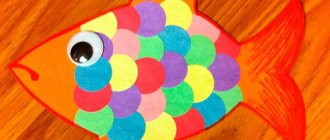Target. Continue introducing children to the LEGO DACTA construction set, the shape of LEGO parts that look like bricks, and options for their fastenings. Start of compiling the LEGO dictionary. Develop the skill of distinguishing parts in a box and the ability to listen to the teacher’s instructions.
Equipment. LEGO bricks from sets.
Progress of the lesson
1. Organizing moment
LEGO friend. Hello guys! Do you already know what it is?
Children. This is LEGO.
LEGO friend. Today we will get to know him further. What did you learn about him in the last lesson?
Children's answers.
Game "Magic Color"
Children sit near a box with LEGO and, on the instructions of a LEGO friend, quickly find bricks of a given color. The tasks can be different, for example, “Who is the first?” Boys quickly find 2 blue bricks, and girls - 2 red ones. Boys find red and yellow bricks, girls find green and yellow, etc.
2. Introduction to bricks
LEGO friend. We have already learned everything about the color of LEGO parts, and now we are learning secrets about their shape. Guys, here are LEGO parts. Look what they look like.
Children. On bricks.
LEGO friend. Are the bricks the same or different in some way? How?
Children's answers.
LEGO friend. Look guys, each brick has these attachments that hold together tightly when you connect them. Think about what you can call them? What do they remind you of?
Children's answers: buttons, wells, buckets, circles, etc.
LEGO friend. Let's count how many buttons there are on LEGO bricks.
Children, together with a LEGO friend, count the buttons on LEGO pieces horizontally and vertically.
Thus, children, together with a LEGO friend, look at 4 types of bricks: 2x2, 2x4, 2x6, 2x8.
LEGO friend. Guys, these are magic good bricks. You and I learned that they are all different, they have buttons that fasten one brick to another. You can play with them and make different buildings. They must be handled very carefully, then you yourself will become wizards.
Brick loves affection!
Then you will build a fairy tale!
3. Graphic exercises
An assignment from a LEGO friend.
Game "Designer"
Children are offered strips of paper of various lengths.
LEGO friend. We will be designers, we will come up with various fastenings of LEGO elements. Draw your options for fastening LEGO parts on these strips.
4. Game to develop orientation in LEGO parts
It is carried out in front of a box with LEGO parts.
LEGO friend. Guys, close your eyes, and now open them. Look what brick I found, name it. Now find him. Who's the first?
5. Introduction to fastening options
Game "Staplers"
LEGO friend. Listen to my task. Take one brick with your right hand. And now with your left hand another brick. What a great fellow you are! Now connect them. Happened? Are your bricks holding tightly? Now think about how else you can fasten two bricks - 2x2 and 2x2, 2x4 and 2x4, 2x2 and 2x4, etc.
In the process of fastenings, which the children try themselves, it is necessary to clarify which fastenings will be the strongest, and which ones will not be very strong, etc. The teacher shows those fastening options that the children could not understand themselves, and be sure to draw attention to the fact that the child I made the discovery myself - a fastening option.
6. Clarification of options for impossible fastenings
Game "Unfastened"
The principle of action is the same as in the game “Staples”, i.e. the children themselves show the options to the teacher or LEGO friend. The speech therapist (LEGO friend) shows those options that the children could not understand on their own, and always pays attention (praise) to the fact that the child himself made a discovery - an option for an impossible connection.
Teacher. A LEGO friend was given a task at a toy factory: to determine how parts should not be fastened together, but he could not solve it. Help him.
7. Classification
It is carried out similarly to the classification of parts by color. Only now children must build towers (walls, stairs, etc.) from LEGO bricks, focusing on size. For example, they build towers with 2x2 bricks, or a wall with 2x4 bricks, etc.
8. Constructive play activities and children's speech development
Teacher. Guys, let's make a gift for our mothers now. But first, let's think about what we will do. A LEGO friend has prepared a new pattern for you.
Analysis of the diagram and children's answers.
9. Bottom line
LEGO friend. You are so great! You played so well and learned so many new things. What else have you learned about LEGO in our magical land?
Children's answers.
Summary of the lesson on light construction “The unique LEGO WORLD is a landmark for our friendship!”
Lesson notes on light engineering
“The unique LEGO WORLD is a landmark for our friendship!”
Teacher-psychologist "MBDOU No. 220" Iovina Anna Fedorovna
Target:
Formation of communicative abilities of preschoolers with developmental disorders through the use of LEGO construction technology in psychological and pedagogical correctional and developmental work.
Tasks:
- Establish harmonious relationships in the group based on trust, mutual support and assistance.
To create situations that require communication and active interaction, to form preschoolers’ readiness for joint activities with peers.
To develop the skill of establishing contacts between preschoolers and peers and adults, the ability to interact and collaborate, and to work harmoniously in a team to achieve their goals.
To form positive attitudes towards various types of work and creativity in the group.
Equipment:
Lego set for building a house, a set of three-dimensional figures.
Audience:
senior preschoolers (compensatory preparatory group with various disabilities)
Progress of the lesson:
Introductory part (2-3 minutes) - statement of the problem and task.
Teacher-psychologist: Guys, yesterday I met my fairy-tale friend Leopold the Cat. He was very upset and did not smile like before.
What's happened? – I asked Leopold. And then he told me about his trouble. He decided to build a House of Friendship, in which all the animals would be friends, play together, communicate, help each other, and finally, when the construction was completed, Leopold began to invite his friends to his new beautiful house. He tried very hard, he wanted everyone to like the house and everyone to live together. But while he was calling his friends, mice snuck into the house and gnawed through the floor, walls and windows. And when Leopold returned with his friends, almost nothing was left of the former colorful house. Friends saw such a house and did not want to go into it. They did not support the cat, but began to laugh at him, and even said: What kind of cat are you if you can’t even catch mice? But Leopold did not catch or eat mice, because his main principle was to live together. On the day I met him, this all happened.
Guys, can we help Leopold build a new house, even more beautiful and bigger, so that all of his friends can fit in it? (Children's answers) Okay guys, then you and I are going to our unique LEGO WORLD!
Introductory part (2-3 minutes) – introduction to the world of Lego
Teacher-psychologist: parts from our unique LEGO WORLD will help us build a house!
Lego came to us from afar, from Denmark. They make these magical details there. The basis of a Lego piece is a piece, which is a plastic block connected to other similar bricks on spikes or buttons. All Lego pieces are measured in buttons. (visual explanation with details)
The main part (10-15 minutes) is the construction of the House of Friendship.
First stage (5-7 minutes)
We will build a house from LEGO
We will live together in it
With a smile on our face we can
Relax, play, make friends!
So, let's begin our construction. We'll start by building the foundation. (joint work of a teacher-psychologist with children, providing assistance in completing the task)
Guys, let's decide how many floors there will be in the house? A collective decision is made, after which the second stage of construction begins.
Guys, you are great! We have already built several (?) floors. Let's take a little rest.
Physical exercise “Lego house!” (2-3 minutes)
One, two, three - fold the parts (alternately open three fingers on each hand and connect)
So that they become a figure (we interlock all the fingers)
Assemble the brick, then (unclasp your hands and draw a circle around you)
Don't forget to build a house. (we wave the index finger of our right hand)
You can go right to the threshold (bend over, join hands with palms down)
Pave the way for him (we move our hands over the floor imitating a path)
Choose a place for the bridge - (point with your right hand to the right, with your left to the left)
That will be beauty! (We show class, thumbs of the right and left hands up, the rest of the fingers in fists)
Second stage (5-7 minutes)
Educational psychologist. It's great we warmed up with you guys. Now we can continue our construction. Let's start constructing the roof. The house must be strong and stable.
Guys, what do you think we might have forgotten to build in our big beautiful house so that it would be bright and comfortable to enter? (Children's answers). Well, of course, windows and doors. Now we will build them.
Look how big and beautiful the House of Friendship you have built. You guys are great. Now Leopold will be able to fulfill his dream and invite his friends to his new home and live together with them!
Final part (3-5 minutes) Open discussion
Issues for discussion:
Guys, what do you think, did Leopold’s friends do the right thing when they didn’t support him, abandoned him in trouble and started laughing?
Can they be considered real friends?
What is friendship and who can be considered a true friend?
What should Leopold's true friends have done?
What do you think the mice and Leopold's friends will do when they see the new home?
Do you guys have friends?
Who would you invite into your home?
Teacher-psychologist: that’s right guys, because friendship manifests itself in mutual assistance, support, respect and mutual understanding. Today you showed yourself as true friends, helped each other, communicated, showed respect for your friends, that’s why we got such a wonderful, big and beautiful house called “Friendship!”
Photo report for the lesson of educational psychologist Iovina A.F.
DOCX / 4.39 Mb Photo by teacher-psychologist MBDOU No. 220 Iovina A.F.







